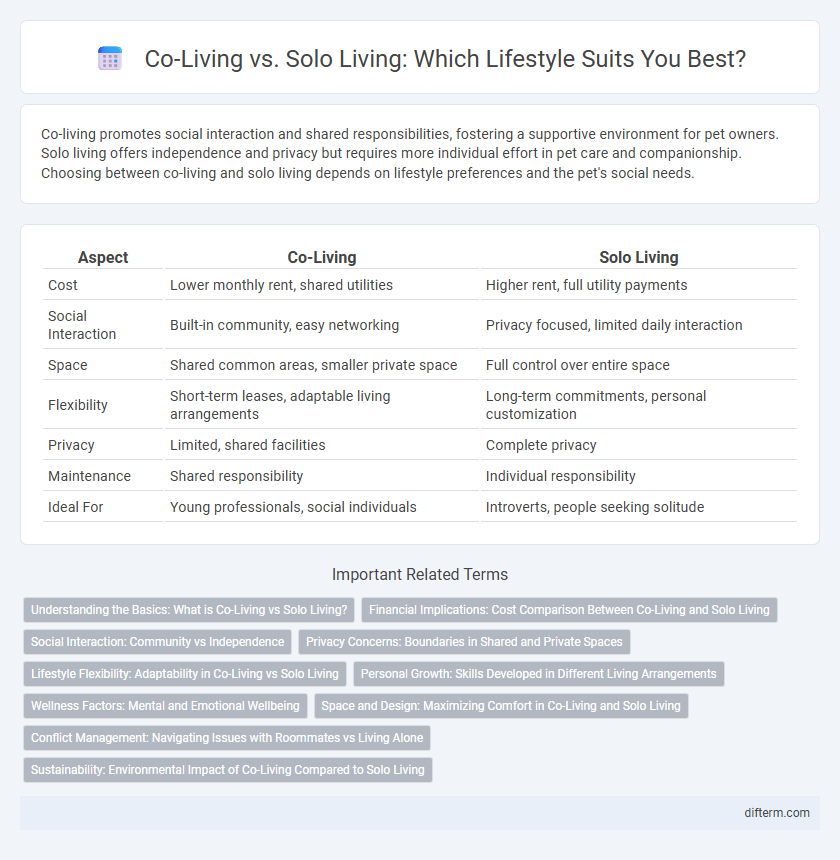Co-living promotes social interaction and shared responsibilities, fostering a supportive environment for pet owners. Solo living offers independence and privacy but requires more individual effort in pet care and companionship. Choosing between co-living and solo living depends on lifestyle preferences and the pet's social needs.
Table of Comparison
| Aspect | Co-Living | Solo Living |
|---|---|---|
| Cost | Lower monthly rent, shared utilities | Higher rent, full utility payments |
| Social Interaction | Built-in community, easy networking | Privacy focused, limited daily interaction |
| Space | Shared common areas, smaller private space | Full control over entire space |
| Flexibility | Short-term leases, adaptable living arrangements | Long-term commitments, personal customization |
| Privacy | Limited, shared facilities | Complete privacy |
| Maintenance | Shared responsibility | Individual responsibility |
| Ideal For | Young professionals, social individuals | Introverts, people seeking solitude |
Understanding the Basics: What is Co-Living vs Solo Living?
Co-living is a shared housing arrangement where individuals or groups live together in a communal space, sharing common areas and amenities while maintaining private bedrooms, fostering social interaction and cost efficiency. Solo living involves residing independently in a private apartment or house, providing full autonomy but often at a higher financial and maintenance responsibility. Co-living appeals to those seeking community and reduced living expenses, whereas solo living suits individuals prioritizing privacy and personal freedom.
Financial Implications: Cost Comparison Between Co-Living and Solo Living
Co-living arrangements typically reduce monthly expenses by sharing rent, utilities, and amenities, making them more affordable compared to solo living, where individuals bear the full cost of housing and bills alone. Rent prices for co-living spaces can be 30-50% lower per person than renting a solo apartment, significantly easing financial burdens, especially in high-demand urban areas. While solo living offers privacy, the increased costs for rent, utilities, and maintenance often outweigh the financial benefits fewer shared resources provide.
Social Interaction: Community vs Independence
Co-living fosters vibrant social interaction by creating shared spaces that encourage collaboration, networking, and a strong sense of community among residents. Solo living prioritizes independence, offering privacy and personal freedom without the constant presence or responsibilities of others. Choosing between co-living and solo living depends on valuing communal support and social engagement versus solitary comfort and self-reliance.
Privacy Concerns: Boundaries in Shared and Private Spaces
Co-living arrangements often pose significant privacy concerns due to shared common areas, requiring clear boundaries and mutual respect to maintain personal space. Solo living guarantees complete control over private spaces, enhancing individual privacy and reducing potential conflicts. Effective management of boundaries in co-living environments can mitigate privacy issues while fostering a collaborative lifestyle.
Lifestyle Flexibility: Adaptability in Co-Living vs Solo Living
Co-living offers greater lifestyle flexibility by providing shared amenities and a built-in social network, allowing residents to easily adapt their schedules and routines to communal activities or collaborative work environments. Solo living grants full control over daily habits and space customization, appealing to those who prioritize independence and personalized routines without compromise. Both lifestyles demand adaptability, but co-living emphasizes dynamic social interaction while solo living centers on solitary autonomy.
Personal Growth: Skills Developed in Different Living Arrangements
Co-living fosters interpersonal skills such as communication, conflict resolution, and empathy through daily interactions with diverse individuals. Solo living cultivates self-reliance, time management, and introspection by encouraging independence and personal responsibility. Both arrangements offer unique opportunities for personal growth, with co-living enhancing social competencies and solo living promoting autonomy and self-discipline.
Wellness Factors: Mental and Emotional Wellbeing
Co-living environments foster social connections and reduce feelings of isolation, promoting improved mental health through shared experiences and support networks. Solo living offers greater autonomy and personal space, which can enhance emotional wellbeing by allowing individuals to establish routines and mindfulness practices tailored to their needs. Both lifestyles influence stress levels and happiness differently, making the choice critical for optimizing mental and emotional wellness.
Space and Design: Maximizing Comfort in Co-Living and Solo Living
Co-living spaces often utilize multifunctional furniture and shared common areas to maximize comfort and foster social interaction, optimizing limited square footage for collective use. Solo living prioritizes personalized design choices and spatial flexibility, allowing occupants to tailor layouts and decor to individual preferences, enhancing privacy and comfort. Both approaches integrate efficient use of space and thoughtful design elements to achieve maximum livability within varying lifestyle needs.
Conflict Management: Navigating Issues with Roommates vs Living Alone
Conflict management in co-living requires effective communication, empathy, and negotiation skills to resolve shared space disputes promptly; living alone eliminates roommate conflicts but demands self-discipline for maintaining order and addressing personal challenges independently. Co-living environments foster collaboration and compromise, often improving social skills, while solo living offers complete autonomy and privacy, reducing stress related to interpersonal disagreements. Balancing the benefits of shared responsibilities with potential conflicts is key to thriving in a co-living setup, whereas solo living prioritizes personal space and freedom.
Sustainability: Environmental Impact of Co-Living Compared to Solo Living
Co-living significantly reduces environmental impact by sharing resources such as energy, water, and appliances, lowering per capita consumption compared to solo living. Shared spaces and communal services result in less waste generation and higher efficiency in heating, cooling, and electricity use. Studies show co-living can reduce carbon footprints by up to 40% per resident versus traditional solo living arrangements.
Co-Living vs Solo Living Infographic

 difterm.com
difterm.com